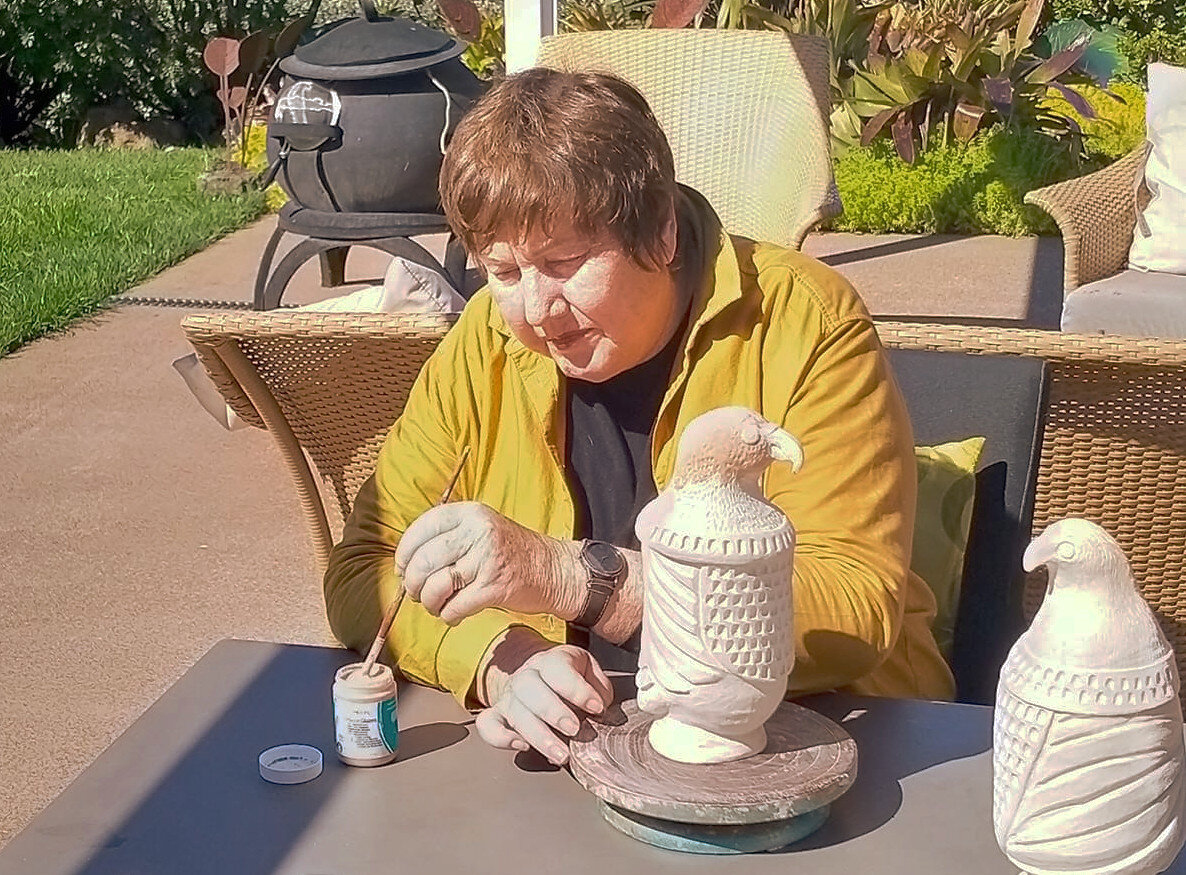Belinda Fabris
Belinda at work on her Conopic Jars fashioned from our native NZ birds.
Waiheke based sculptural artist, Belinda Fabris uses ceramics and clay as her primary medium. Fabris’ pieces challenge the values and perceptions of the viewer with a variety of quirky character sculptures with animal-like features, but very human backstories. A playfulness and detail elevates these works – they are not caricatures, but lovingly distorted reflections of our own human behaviours. Her canopic bird jars are her next foray, expressing her love and protection for Waiheke’s bird life.
Michelle Barber: What's your background?
Belinda Fabris: I was born and raised on Mt Albert in Auckland. My mother and grandmother were highly creative, independent and entrepreneurial women. My father’s creativity provided a beautiful garden for my brother and I to grow up in. I’ve always loved art, however, I began my career path in a medical laboratory. I broadened my horizons and traveled and worked in Australia, Papua New Guinea, Europe and London. On my return to New Zealand, I became involved in the commercial side of science. Then I purchased my own recruitment business which kept me busy until I sold it in 2008.
My husband Steve and I then took time out and lived on our boat for a while. We loved visiting Waiheke; the island of artists, lovers of the sea, and fishing, it was a perfect combination. Waiheke felt like home to us both. We have been full time residents here for 8 years and soon after arriving, I enrolled in the Otago distance learning Diploma of Visual Arts and established my ceramic studio.
MB: What does your art say about you?
BF: My fascination with the human race is expressed in my outdoor ceramic figures. Everyone has a story, some people think they are important, others have peculiar traits which are funny. These ceramic caricatures help us laugh about ourselves, celebrate our individuality, our vulnerability, and our need for acknowledgement. The sculptures come with a 'birth certificate” and background story which aims to connect and amuse the viewers to them.
Also, I am passionate about the welfare of our native birds, so I have created a series of birds, fashioned in the look of ancient Egyptian canopic jars which were used to preserve essential organs in preparation for rebirth. The Egyptians also believed in speaking directly to the gods by leaving letters in the tombs, so for this reason I have placed a scrolled letter in each jar which explains the threats the bird is suffering and asks for help. My political and social artwork is more confrontational and I look to provoke a response from the viewers. I think it is important to question our values, both as individuals and as a society.
MB: What ceramic techniques do you utilise in your practice?
BF: I hand build and slab build my figurative outdoor sculptures incorporating the use of decals, small casts, and crystal glazes to extend the narrative. My bird jars are thrown on a wheel and then decorated with sgraffito (meaning ‘scratched’ in Italian) patterns. The bird's head is then hand built on the lid.
In regards to my social commentary artwork; I like to think anything goes and I will use a mix of media. I'm partial to familiar items with which the viewer can identify. I also custom make and slip cast molds and do multiple firings to achieve the desired effect. Primarily I use an electric kiln in my studio however I love the challenge of outdoor raku firings. Originally a traditional Japanese firing technique, raku is well suited to a small studio setup. I feel that I'm on a journey with raku – nothing better than a lit flame and a fast firing to get a bit of excitement into your life.
MB: Who are your biggest artistic influences?
BF: I love the unbridled, nonconformist attitude of UK ceramic artist Grayson Perry and his ruthless mockery of any form of art pretension. His influence encourages me to be outspoken and hopefully, down to earth. His work is beautifully nuanced in layers of meaning. I admire the power of clear, clean symbolism in Banksy’s art and how he chooses to communicate directly with people on the street.
I'm inspired by Yinka Shonibare, a contemporary British Nigerian multi-media artist, who confronts social prejudice in subtle, beautifully crafted pieces. His use of the metaphors of culture is powerful.
MB: What else do you do? And does this influence your work?
BF: I'm sustained by interaction with art colleagues, such as group raku firings, local shows, and collaborations. I enjoy meeting the people who collect my work because they have a very good sense of humour. I enjoy having other artists working in the studio with me, it brings freshness and fun. I do enjoy working with the Jassy Dean Trust and helping to promote more art in home gardens.


